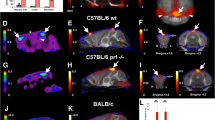Abstract
To assess the interaction between the cellular elements of the blood and neurovascular endothelia in cerebral malaria, brain tissue from adult rhesus moneys (Macaca mulatta) infected with a virulent (W1) strain of Plasmodium knowlesi were studied by light and electron microscopical techniques. Light microscopical examination showed sequestration of macrophages and margination of erythrocytes containing late stages of the parasite in the capillaries and venules throughout the brains of the infected monkeys. Brain microvascular lesions (associated with parasitised erythrocytes and macrophage attachment to vascular walls) seen with the electron microscope, were swelling of the endothelial cells, formation of pseudopodia, increased numbers of pinocytotic vesicles and disorganisation of the mitochondria. Parasitised mature erythrocytes and macrophages adhered to the vascular endothelial lining in equal proportions. The endothelial ultrastructural alterations were similar to those described in experimental rodent and in clinical human cerebral malaria.
Similar content being viewed by others
References
Aikawa M (1988) Human cerebral malaria. Am J Trop Med Hyg 39:3–10
Areekul S, Kasemsuth R, Kanakakorn K (1984) Studies on transcapillary escape rate of fibrinogen and capillary permeability in patients with Plasmodium falciparum malaria. Trop Geog Med 36:151–157
Bate CAW, Taverne J, Playfair JHL (1988) Malarial parasites induce TNF production byh macrophages. Immunology 64:227–231
Berendt AR, Simmons DL, Tansey J et al. (1989) Intercellular adhesion molecule-1 is an endothelial cell adhesion receptor for Plasmodium falciparum. Nature 341:57–59
Bruce-Chwatt LJ (1985) Clinical course of malaria, essential malariology William Heinemann, London: pp 51–72
Clark IA, Ilschner S, MacMicking JD et al. (1989) TNF and Plasmodium berghei ANKA-induced cerebral malaria. Immunol Lett 25:195–198
Cotran RS (1987) New roles for endothelium in inflammation and immunity. Am J Pathol 139:407–413
Curfs JHAJ, Schetters TPM, Hermesen CC et al. (1989) Immunological aspects of cerebral lesions in murine malaria. Clin Exp Immunol 75:136–140
Franz DR, Lee M, Seng LT et al. (1987) Peripheral vascular pathophysiology of Plasmodium berghei infection: a comparative study in the cheek pouch and brain of the golden hamster. Am J Trop Med Hyg 36:474–480
Grau GE, Taylor TE, Molyneux ME et al. (1989) Tumour necrosis factor and disease severity in children with falciparum malaria. N Engl J Med 320:1586–1591
Grau GE, Biela G, Pointare P et al. (1990) Significance of cytokine production and adhesion molecules in malaria immunopathology. Immunol Lett 25:189–194
Howard RJ, Gilladoga AD (1989) Molecular studies related to the pathogenesis of cerebral malaria. Blood 74:2603–2618
MacPherson GG, Warrell MJ, White NJ et al. (1985) Human cerebral malaria: a quantitative ultrastructural analysis of parasitised erythrocyte sequestration. Am J Pathol 119:385–401
Maegraith BG, Fletcher A (1972) The pathogenesis of mammalian malaria. Adv Parasitol 10:49–75
Marchiafava E, Bignami A (1900) malaria. In: Twentieth century practice of medicine. An international encyclopedia of modern medical science. New York 19:227–252
Miller LH, Fremount HN, Luse SA (1971) Deep vascular schizogony of Plasmodium knowlesi in Macoca mulatta: distribution in organs and ultrastructure of parasitised red cells. Am J Trop Med Hyg 20:816–824
Oo MM, Aikawa M, Than T et al. (1987) Human cerebral malaria: a pathological study. J Neuropathol Exp Neurol 46:223–231
Oquendo P, Hundt E. Lawler J et al. (1989) CD36 directly mediates cytoadherence of P. falciparumparasitised erythrocytes. Cell 58:85–101
Pober JS (1988) Cytokine-mediated activation of vascular endothelium. Am J Pathol 3:426–433
Rest JR (1982) Cerebral malaria in inbred mice: I. A new model and its pathology. Trans R Soc Trop Med Hyg 76:410–415
Rest JR, Wright DH (1979) Electron microscopy of cerebral malaria in golden hamsters (Mesocricetus auratus) infected with Plasmodium berghei. J Pathol 127:114–120
Roberts DD, Sherwood JA, Spitalnik SL et al. (1989) Thrombospondin binds falciparum malaria parasitised erythrocytes and may mediate adherence. Nature 318:64–66
Schmal FW, Schlote W, Urbaschek B et al. (1982) Reactions of endothelial cells of cerebral vessels in endotoxic shock. In: Proceedings of the 5th annual conference on shock, Toronto, pp 192–193
Spitz S (1946) The pathology of acute falciparum malaria. Milit Surg 99:555–572
Stolpen AH, Guinan EC, Fiers W et al. (1986) Recombinant tumour necrosis factor and immune interferon act singly and in combination to reorganize human vascular endothelial cell monolayers. Am J Pathol 123:16–24
Taverne J, Bate CAW, Sarkar DA et al. (1990) Human and murine macrophages produce TNF in response to soluble antigens of Plasmodium falciparum. Immunology 64:227–231
Toro G, Roman G (1978) Cerebral malaria. A disseminated vasculopathy. Arch Neurol 35:271–275
Warrell DA, Looareesuwan S, Phillips RE et al. (1986) Function of the blood-cerebrospinal fluid barrier in human cerebral malaria: rejection of the permeability hypothesis. Am J Trop Med Hyg 35:882–889
Warrell DA, Molyneux ME, Beals PF (eds) (1990) Severe and complicated malaria. Trans R Soc Trop Med Hyg 84:Suppl.2:1–65
Yoeli M, Hargreaves BJ (1974) Brain capillary blockage produced by a virulent strain of rodent malaria. Science 1984:572–573
Yu WA, Yu MC, Young PA (1974) Ultrastructural changes in the cerebrovascular endothelium induced by a diet high in finoleic acid and deficient in vitamin E. Exp Mol Pathol 21:289–299
Author information
Authors and Affiliations
Rights and permissions
About this article
Cite this article
Ibiwoyel, M.O., Sibbons, P.D., Howard, C.V. et al. Cerebral malaria in the rhesus monkey (Macaca mulatta): Light and electron microscopic changes in blood cells and cerebrovascular endothelia. Comparative Haematology International 3, 153–158 (1993). https://doi.org/10.1007/BF00186099
Issue Date:
DOI: https://doi.org/10.1007/BF00186099




